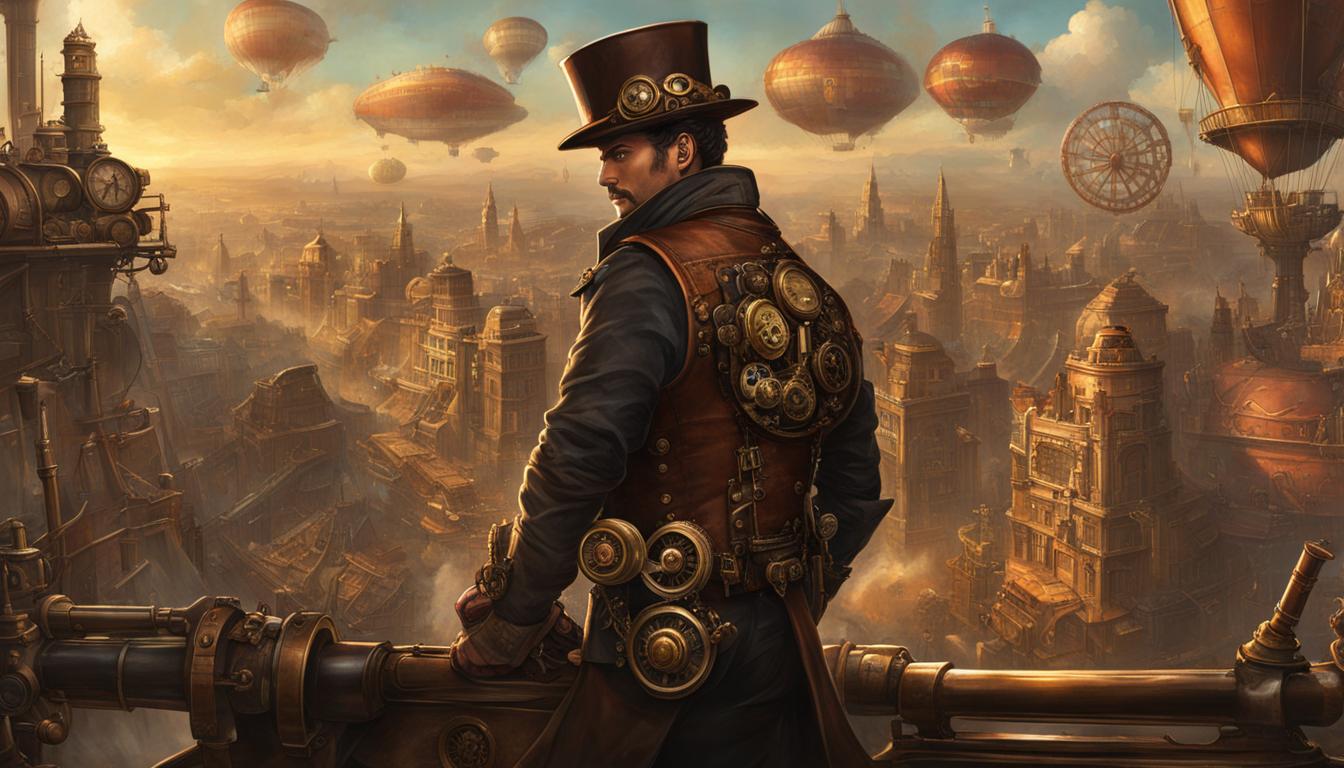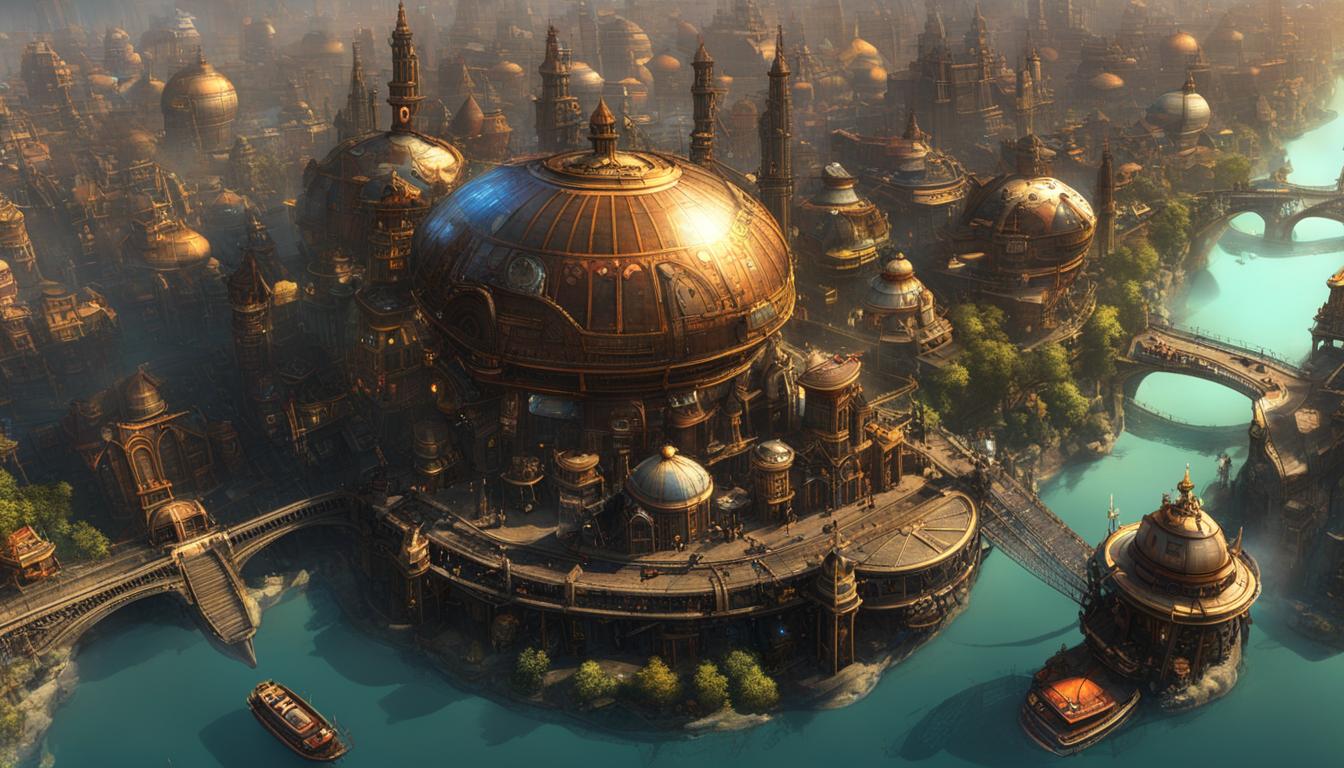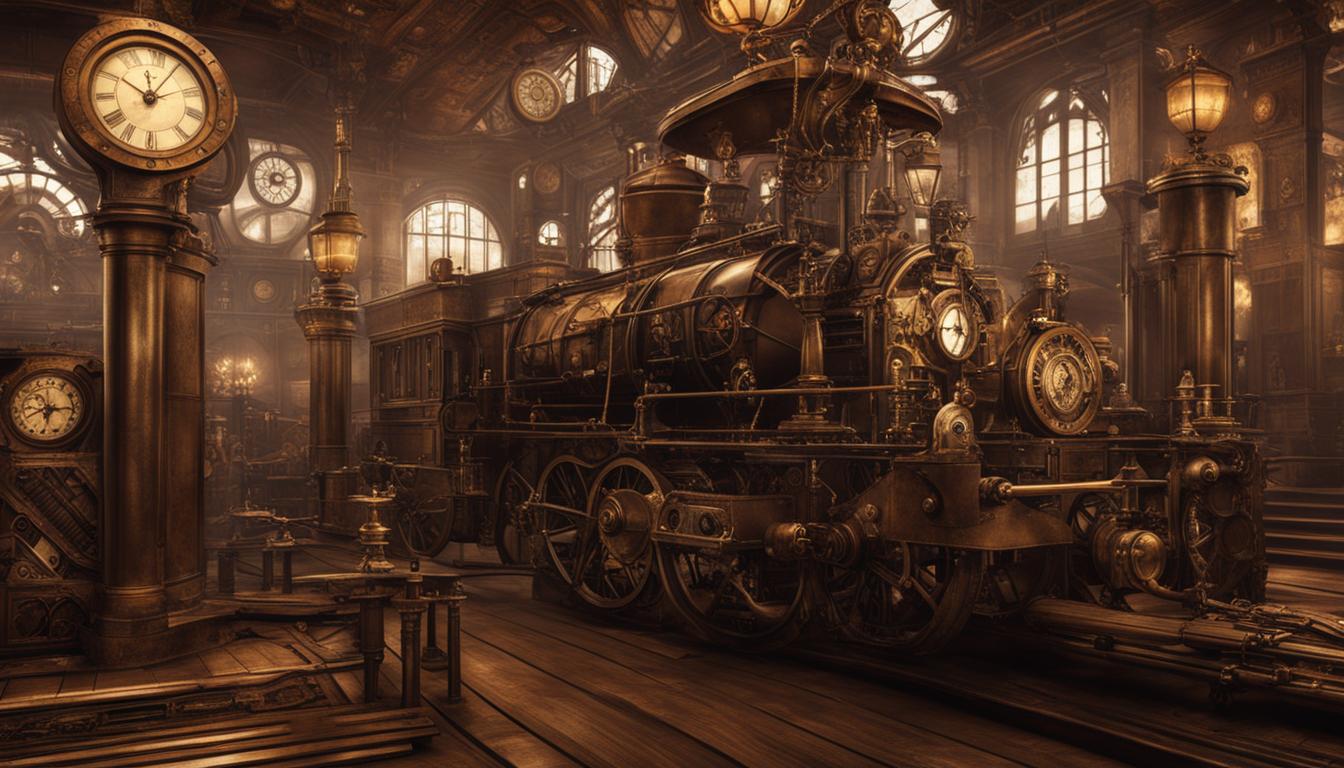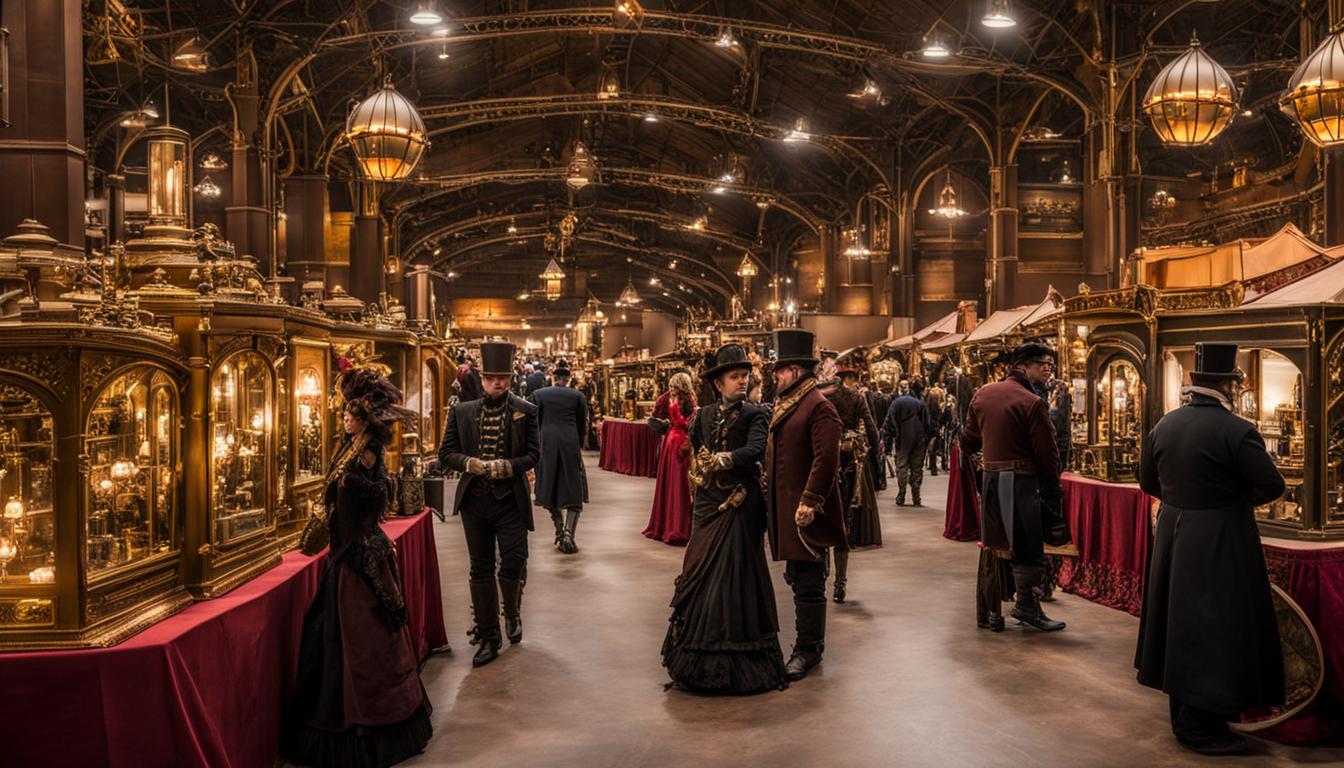Steampunk design has taken the gaming world by storm, leaving an indelible mark on the industry. With its unique blend of 19th-century aesthetics and science fiction elements, steampunk has captured the imagination of gamers and developers alike.
From the distinct art style of Dishonored to the technologically advanced world of Final Fantasy VI, video games have embraced steampunk design elements to add depth and innovation to their visuals.
Key Takeaways:
- Steampunk design has had a significant influence on the gaming industry.
- Video games have incorporated steampunk elements to enhance their visual appeal.
- Steampunk combines 19th-century aesthetics with science fiction elements.
- Dishonored and Final Fantasy VI are examples of games that showcase steampunk design elements.
- Steampunk design adds depth and innovation to video game visuals.
The Evolution of Steampunk in Gaming
Steampunk has come a long way since its introduction into the gaming world. What started as a niche genre has evolved into a prominent design choice for many video games. Developers have pushed the boundaries, going beyond simple nods to steampunk and fully immersing players in its captivating aesthetic and innovative elements.
Games like Thief: The Dark Project have taken steampunk to new heights by leveraging environmental interaction and lighting effects to create a heightened sense of mood and atmosphere. Arcanum: Of Steamworks and Magick Obscura blends the mystical with the industrial, offering players a world brimming with imaginative possibilities. And Darkwatch takes players on a Wild West adventure with a steampunk twist, showcasing the versatility of the genre.
These innovative designs demonstrate the allure of steampunk in game development. By embracing the unique visual style and blending it with compelling gameplay mechanics, developers have created immersive experiences that transport players to fantastical worlds filled with Victorian aesthetics and futuristic technology.
To truly appreciate the evolution of steampunk in gaming, it’s essential to experience these games firsthand. Dive into the gloomy and atmospheric setting of Sunless Sea or embark on a whimsical adventure in Professor Layton and The Curious Village. Explore the intricate puzzles of The Room, brave the frozen wasteland of Frostpunk, or immerse yourself in the charming world of Machinarium. These steampunk-inspired games offer a taste of the creativity and innovation that can be found within the genre.
The evolution of steampunk in gaming is a testament to the power of design and the boundless imagination of game developers. As the industry continues to push the boundaries of what is possible, we can expect to see even more innovative and immersive steampunk experiences that captivate players and transport them to extraordinary worlds.
The Importance of Collaborating with Architects and Landscape Architects
Collaborating with architects and landscape architects can be a game-changer for the design and development of video games. These professionals bring a wealth of knowledge and expertise to the table, ensuring that game environments are not only visually stunning but also seamless and immersive.
When working with architects in gaming design, their conceptual thinking and critical approach can elevate the realism and coherence of game environments. They understand how to create 3D spaces that feel authentic and functional, taking into consideration factors such as scale, proportion, and spatial relationships.
Landscape architects, on the other hand, have a keen eye for creating natural and built environments that blend seamlessly. They can enhance the visual appeal of game worlds by integrating landscape elements, such as vegetation, water features, and terrain, into the design. By working with landscape architects, game developers can create immersive and believable game worlds that players can explore and get lost in.
Collaborating with architects and landscape architects brings a fresh perspective to game development, ensuring that every aspect of the environment is carefully considered and designed. It’s about creating a sense of place that feels real and engaging, which ultimately enhances the overall player experience.
Advantages of Collaborating with Architects and Landscape Architects
- Conceptual thinking: Architects and landscape architects can provide unique and creative solutions to design challenges, bringing fresh ideas and perspectives to the table.
- User experience: These professionals understand how to create spaces that are not only visually appealing but also functional and intuitive for players to navigate.
- Attention to detail: Architects and landscape architects pay meticulous attention to every aspect of design, from the placement of objects to the choice of materials, ensuring a cohesive and immersive experience.
Overall, collaborating with architects and landscape architects can greatly enhance the design and development of video games. Their expertise in creating immersive 3D environments, considering user experience, and seamlessly integrating architecture and landscape can elevate the realism and coherence of game environments, enhancing gameplay immersion and overall player experience.
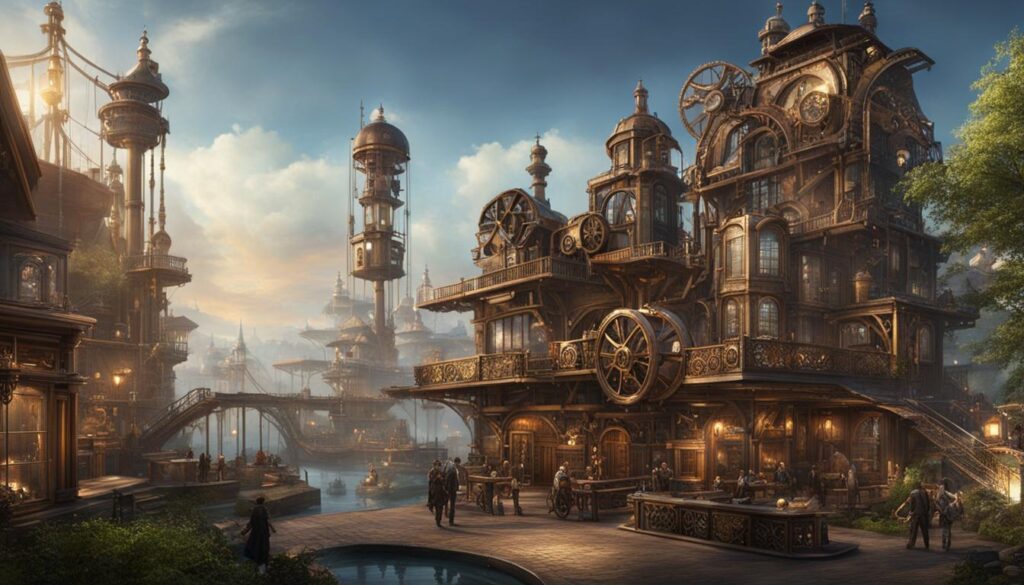
Enhancing Environmental Design in Video Games
Environmental design plays a crucial role in creating immersive and captivating video game experiences. From developing architectural narratives to carefully selecting and deploying materials and textures, game developers have the power to bring game worlds to life. By incorporating these elements, video games can offer players a visually stunning and cohesive experience that enhances gameplay immersion.
One key aspect of enhancing environmental design in video games is developing architectural narratives. Just as in real-life architecture, game developers can create a story within the buildings and structures found in the game world. The architecture can reflect the history, culture, and purpose of the virtual world, providing players with a deeper understanding and connection to the environment they are exploring. Whether it’s a towering gothic cathedral or a dilapidated steampunk factory, the architectural design can convey a sense of place and add depth to the overall narrative of the game.
“Architectural narratives are an integral part of creating engaging game environments,” says game designer Jane Stone. “By carefully crafting the design of buildings and structures, we can immerse players in a world that feels rich, believable, and full of stories waiting to be discovered.”
In addition to architectural narratives, the building design itself plays a significant role in enhancing the environmental design in video games. Purpose-built buildings can contribute to the realism and immersion of the game world. From intricate mazes in dungeon-crawler games to intricately designed cityscapes in open-world adventures, the building design can significantly impact the gameplay experience. Attention to detail, such as the placement of windows, doorways, and architectural styles, can create a visually appealing and cohesive game environment that draws players deeper into the game’s world.
Deploying materials and textures effectively is another important aspect of environmental design in video games. The choice of materials can evoke a specific atmosphere or convey the technological level of the game world. From the shiny brass of steampunk contraptions to the weathered wood of a post-apocalyptic town, the materials used in the game environment can enhance the visual coherence and overall immersion. Textures can add depth and realism to objects and surfaces, making the game world feel more tangible and engaging.

Table: Examples of Building Designs in Video Games
| Game | Building Design |
|---|---|
| BioShock Infinite | Missed the opportunity to fully embrace a steampunk aesthetic by not customizing building designs to support the game’s narrative |
| The Witness | Integrates architecture and landscape, creating a rich narrative that evolves as players explore different environments |
| The Legend of Zelda: Breath of the Wild | Features diverse building designs that reflect the different cultures and regions within the game world |
By focusing on developing architectural narratives, building purpose-built designs, and deploying materials and textures effectively, game developers can enhance the environmental design in video games, creating immersive and visually stunning game worlds that captivate players.
Examples of Steampunk-Inspired Games
Steampunk-inspired video games offer players unique and captivating experiences in fantastical worlds that blend Victorian aesthetics with futuristic technology. These games transport players to immersive environments filled with intricate machinery, airships, and a sense of adventure. Whether you’re a fan of puzzle-solving, exploration, or strategy, there are several popular steampunk games that cater to different gameplay preferences.
One notable steampunk-inspired game is Sunless Sea, a dark and atmospheric exploration game set in an underground ocean. As the captain of a steamship, players navigate treacherous waters, encounter bizarre creatures, and make difficult choices that shape their story. The game’s haunting narrative and richly detailed world create a sense of mystery and intrigue that keeps players engaged throughout their journey.

If you’re looking for a more light-hearted and puzzle-focused experience, Professor Layton and The Curious Village is a charming adventure game set in a whimsical steampunk world. Players step into the shoes of Professor Layton, a renowned puzzle solver, as they unravel the secrets of St. Mystere. The game’s beautiful hand-drawn art style, clever puzzles, and engaging storyline make it a favorite among fans of brain-teasing games.
| Game | Genre | Platform |
|---|---|---|
| The Room | Puzzle | Mobile, PC, Console |
| Frostpunk | Strategy, City Building | PC, Console |
| Machinarium | Adventure, Puzzle | Mobile, PC, Console |
Other steampunk-inspired games worth exploring include The Room, a critically acclaimed puzzle game that challenges players to solve intricate mechanisms within a mysterious steampunk world. Frostpunk, a strategy and city-building game, presents players with a post-apocalyptic steampunk society where they must make difficult moral choices to ensure the survival of their city. Machinarium, an adventure and puzzle game, features a charming hand-drawn art style and a captivating story set in a steampunk city populated by quirky robots.
These games exemplify the diversity and creativity within the steampunk genre, offering players a range of gameplay experiences that are sure to satisfy their curiosity and love for all things steampunk. Whether you’re exploring the depths of an underground ocean or solving intricate mechanisms, these games provide hours of immersive entertainment in beautifully crafted steampunk worlds.
Conclusion
As the gaming industry continues to evolve, the influence of steampunk game design remains evident. Steampunk has brought a unique aesthetic and innovative elements to video games, captivating players with its blend of 19th-century architecture and science fiction elements. The allure of steampunk-inspired games shows no signs of slowing down, as they continue to captivate players and pave the way for new discoveries and innovations.
Furthermore, the collaboration with architects and landscape architects has proven to be invaluable in creating immersive and realistic game environments. Their expertise in integrating architecture and landscape seamlessly adds depth and authenticity to the gaming experience, enhancing gameplay immersion and overall player satisfaction. Moving forward, this collaboration will become even more crucial as technology advances and the demand for visually appealing, fantastical digital worlds increases.
In the future, we can expect to see steampunk-inspired games continue to push boundaries and captivate players with their unique and creative designs. The steampunk genre offers endless possibilities for game developers to explore, from gloomy and atmospheric settings to whimsical and puzzle-filled adventures. As the gaming industry embraces new technologies and design techniques, steampunk game design will undoubtedly play a significant role in shaping the future of gaming.
FAQ
How has steampunk influenced the gaming design industry?
Steampunk has had a significant impact on the gaming design industry, with numerous video games adopting the steampunk genre throughout the years. The unique aesthetic of steampunk, characterized by its blend of 19th-century architecture and clothing with science fiction elements, has captivated gamers and developers alike.
What are some examples of video games that incorporate steampunk design elements?
Some notable examples include Dishonored, Final Fantasy VI, Thief: The Dark Project, Arcanum: Of Steamworks and Magick Obscura, Darkwatch, Sunless Sea, Professor Layton and The Curious Village, The Room, Frostpunk, and Machinarium.
How can collaborating with architects and landscape architects enhance video game design?
Architects and landscape architects bring a depth of knowledge in creating immersive 3D environments, considering user experience, and integrating architecture and landscape seamlessly. Their expertise can elevate the realism and coherence of game environments, enhancing gameplay immersion and overall player experience.
How can environmental design in video games be improved?
Environmental design can be elevated by incorporating architectural narratives, purpose-built building designs, and thoughtful deployment of materials and textures. Understanding the properties of materials and deploying them effectively in game environments can enhance the visual coherence and immersive experience for players.
What are some examples of steampunk-inspired video games?
Examples include Sunless Sea, Professor Layton and The Curious Village, The Room, Frostpunk, and Machinarium.
How has steampunk impacted the gaming industry?
Steampunk design has left a lasting impact on the gaming industry, with its unique aesthetic and innovative elements elevating the visual and immersive experiences in video games. Collaborating with architects and landscape architects has the potential to further enhance the design of game environments, creating cohesive and compelling worlds for players to explore.

